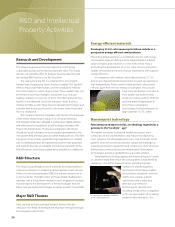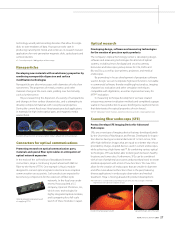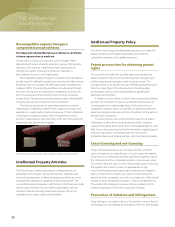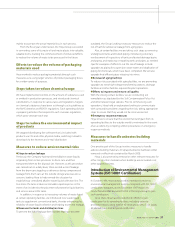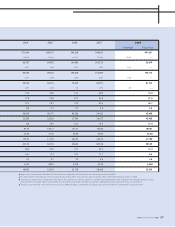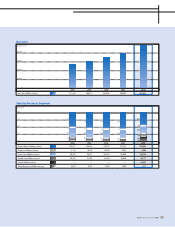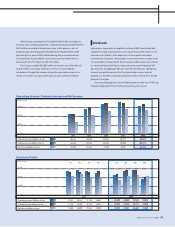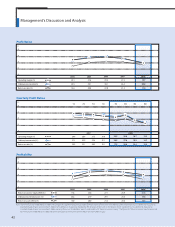Pentax 2008 Annual Report Download - page 34
Download and view the complete annual report
Please find page 34 of the 2008 Pentax annual report below. You can navigate through the pages in the report by either clicking on the pages listed below, or by using the keyword search tool below to find specific information within the annual report.
For Hoya, corporate governance is a matter of utmost importance
to management. Based on its fundamental philosophy that
“companies are owned by their shareholders,” Hoya conducts its
corporate management with the goal of maximizing shareholder
value. To ensure it does not operate according only to internal
thinking on management, Hoya’s outside directors actively
represent shareholders in the capacity of auditors. The Company
has also separated the management and execution functions to
accelerate decision-making and increase management efficiencies.
In June 2003, Hoya instituted a company-with-committees
management system, thereby establishing three committees—
the Nomination Committee, the Compensation Committee and
the Audit Committee—each distinct from the Board of Directors.
The Japanese Corporate Law stipulates that a majority of the
members of the three committees be outside directors, whereas
at Hoya every one of the members are outside directors. Within
the company-with-committees framework, this system enables
delegation of decision-making authority from the Board of
Directors to the executive officers so that they may focus on
speedy and efficient management toward realizing improved
business performance. At the same time, the three committees
composed of outside directors provide enhanced powers of
supervision over the executive officers to ensure overall
soundness and transparency of management.
To guard against the potential for stagnation in the Board of
Directors system, and to ensure lively debate, Hoya has since 1989
been gradually reducing the number of its directors. From a total
of 17 in 1989, the number had been halved to eight as of 1995.
Furthermore, to ensure that views can be freely expressed,
unconstrained by internal hierarchical structures or personal
relationships, the Company has invited outside directors to
participate in its management, beginning in 1995. Increasing in
number each year, the outside directors currently comprise a
majority in the Board of Directors, allowing for managerial
supervision and advice from a third-party perspective outside the
Company. Moreover, we welcomed one additional director, who is
also an executive officer, from outside Hoya at the General
Shareholders’ Meeting held in June 2008, to further enhance
business execution to the accommodate the increasing scale of
operations, including the business integration with Pentax.
Consequently, the Board of Directors now consists of five outside
directors and four internal directors, for a total of nine directors.
The Board of Directors meets every month, excluding
February and August. These meetings ensure that the outside
directors both oversee and offer advice to the executive officers in
their business activities, in an atmosphere that encourages lively
debate. Internal directors serve concurrently as executive officers.
Authority has been further devolved from the executive officers to
the heads of each business division, who are responsible for
day-to-day business operations in their respective areas of activity.
These division heads make detailed reports on each division’s
status to the executive officers at monthly business reporting
meetings, at which strategies for responding to each issue are
discussed. Important matters are all reported to meetings of the
Board of Directors.
The Nomination Committee, Compensation Committee and
Audit Committee each have downstream operations that have
powers of appointment and dismissal and are independent of the
executive officers. All the outside directors in each committee
have plenty of experience in management and possess
international outlooks. Each of them can be expected to offer
impartial and appropriate opinions. At all meetings of the Board of
Directors and the three committees, they offer frank, straight-
forward views.
Nomination Committee
The Nomination Committee decides on the selection of
candidates for appointment as directors and executive officers,
and submits them to the Board of Directors for its decision. The
committee also makes decisions on the referral to Shareholders’
Meetings of proposals to relieve directors of their posts, and on
the referral to the Board of Directors of proposals to relieve
executive officers of their posts. The committee follows standards
for the selection of candidates for appointment as directors to
ensure that appointments are fair and appropriate.
Compensation Committee
The Compensation Committee prepares the remuneration system
that boosts incentives for the directors and executive officers. It
was established with the objective of contributing to improved
financial performance for Hoya, by undertaking fair and accurate
evaluations of results. The remuneration package of each director
is composed of a fixed salary, results-based remuneration and
stock options. Each package is decided based on a consideration
of such factors as prevailing business conditions, financial results
and standards adopted by other companies.
Corporate
Governance
The Board of Directors and the
Three Committees
Corporate Governance Systems
32






